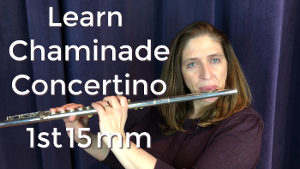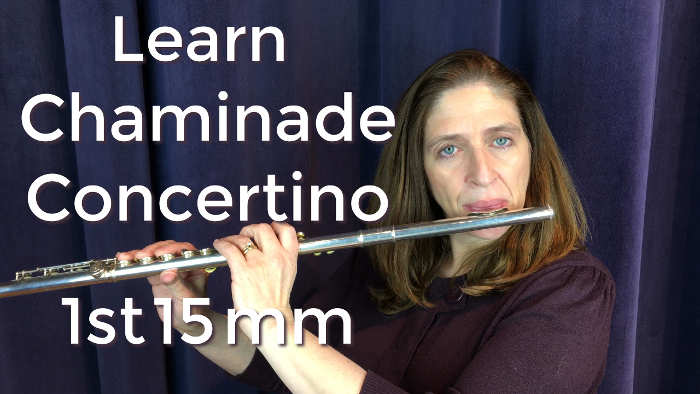Have you ever studied Cécile Chaminade’s Concertino in D Major Opus 107?
Learn with me as I teach through the Concertino in 6 parts, highlighting areas that might be technically and rhythmically difficult.
In this first video I will cover only the first 15 measures. This is the opening to the whole piece. It sets the tone and it’s so beautiful and lovely.
Don’t Rush the Triplets
When students play this opening for me, one of the most common errors they make is in the rhythmic timing of the duplets contrasting with the triplets. The first measures begin with eighth and then immediately move to triplets and back to eighths. It’s back and forth and back and forth.
Almost always if there’s a problem, the triplets are played too fast, they are rushed. The best way to conquer this is to practice these measures with a metronome. Listen very carefully. Even with a metronome they can be played wrong. Don’t try to be musical with it just yet. Learn the rhythm carefully first. Once you feel that you have it down then listen for the phrasing and nuance.
Don’t Start Too Softly
Another mistake that flute players make is beginning the piece too softly. If you begin too softly then most likely you are sacrificing tone. Use the mf to your advantage. If you play mf as it says then you can bring out your tone. It will help you feel like you are beginning strongly. It makes it just so lovely to start off with a beautiful not overly loud sound but just a nice comfortable mf sound.
Lets talk tenuto. Sometimes when students play these tenuto notes they misinterpret what that really means. It does not mean to change the rhythm. I like to think of tenuto notes as sticky notes. I want to think of these notes as if I can’t get off them. I want to play them not too short or too long but elongated and sticky.
Sticky Tenuto
If you hold the tenuto too long, then you will change the rhythm. But, it you hold the tenuto too short, then they are not special.
That covers the opening. Now lets continue and look at the dynamics. There are a lot of them.
In m. 6 it begins with a diminuendo. That causes some consternation. Because at the end of the opening phrase in m. 5 which was your opening phrase, you’ve tapered and gotten softer. Now you must come in louder than when you ended so that you can dim. bigger than that.
Articulate!
Articulation is very important. I haven’t discussed this yet but it is important as we have come to the time in musical history that composers began to write in their own dynamics, which up to this point were either non-existent or sparse. So, now go back to the beginning put all the articulation in, up to this point.
I bet your playing is really beginning to sound nice, isn’t it?
Beginning in m.11 the opening motive is heard again, except this time it is higher. That makes it much more intense and more dramatic. Use that drama to shape these last few measures to m.15.
That’s your opening through measure 15. How is it going for you? Are you feeling like the measures are taking shape? If not, do them again and work harder at expression.
Work on that opening. Explore your range of dynamics and articulation. Make sure that there’s a nice tah where there’s supposed to be a tah. Whatever’s written here was written by the composer. So, put those in. And compare your duplets with your triplets to make sure that you’re not short-changing the triplets by rushing through them.
That’s your 1st 15 measures.
Have fun working on Chaminade.
DoctorFlute
Watch me demonstrate this:
Learn Chaminade 1st 15 Measures Cécile Chaminade Flute Concertino in D Major Op 107

Learn Chaminade mm 15-30 Cécile Chaminade Flute Concertino in D Major Op 107
Learn Chaminade mm 33-70 Cécile Chaminade Flute Concertino in D Major Op 107
Learn Chaminade The Vivo Cécile Chaminade Flute Concertino in D Major Op 107
Learn Chaminade The Cadenza Cécile Chaminade Flute Concertino in D Major Op 107
Learn Chaminade The Presto Cécile Chaminade Flute Concertino in D Major Op 107
